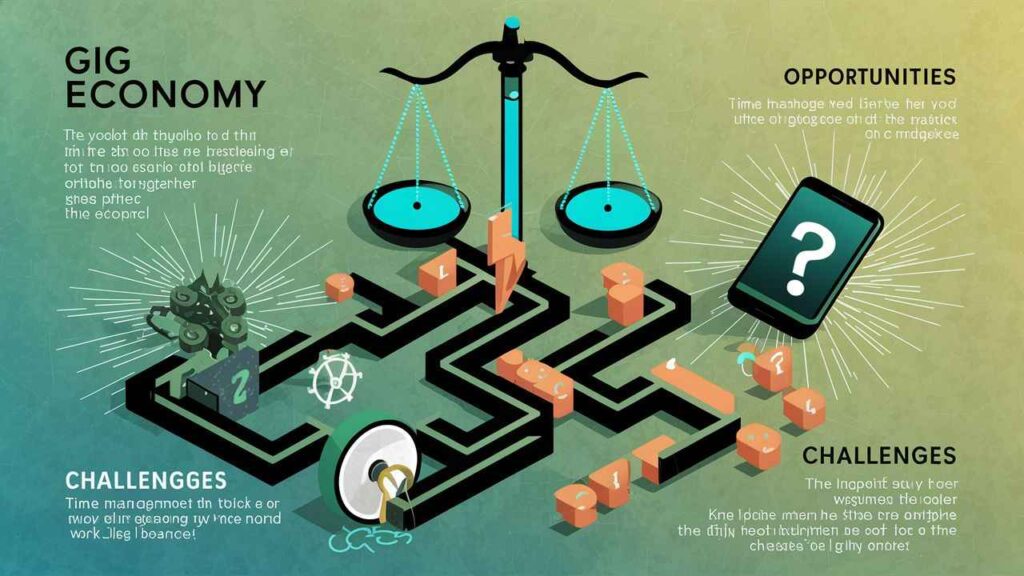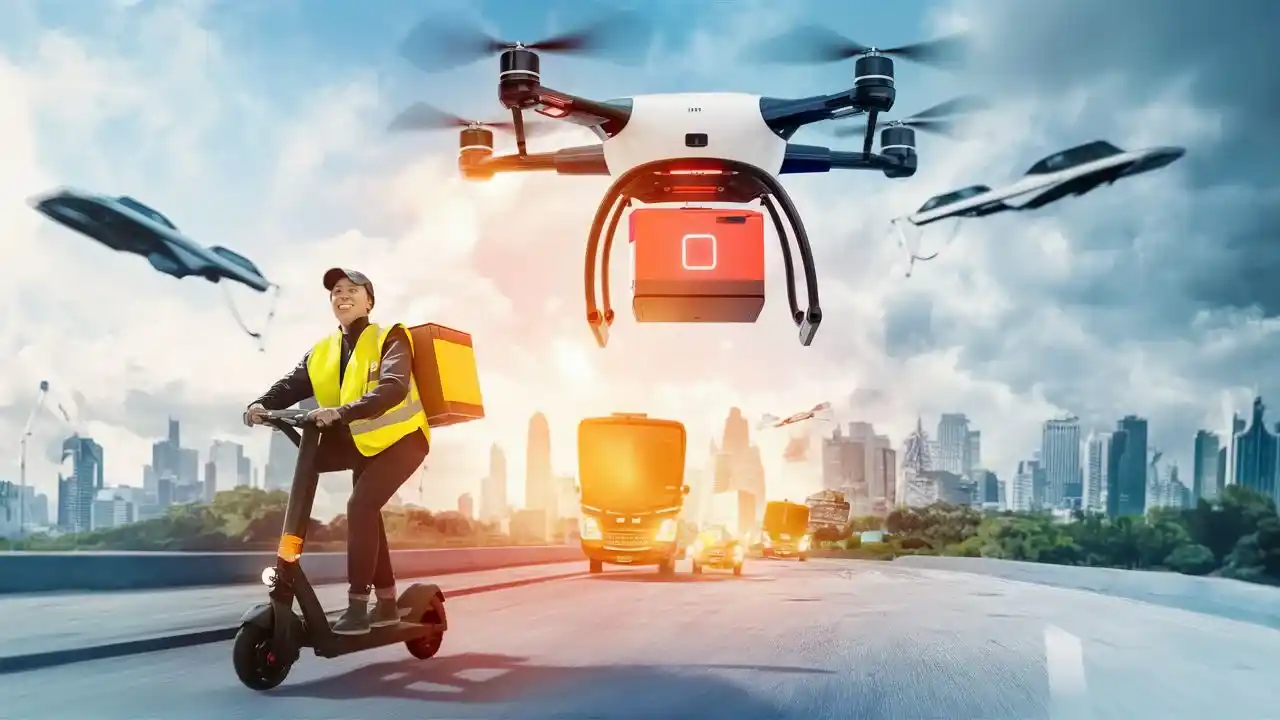Today the gig economy has emerged as a significant force in the job market. It offers opportunities for individuals to work independently, often through digital platforms, and earn income on a flexible basis. While the gig economy presents several advantages, such as flexibility and autonomy, it also comes with its own set of challenges.
In this blog post, we’ll disscus future of gig economy opportunities and challenges. Let’s explore gig work and learn how to do well in this changing field.
How Big Is The GIG Economy In The USA?

The gig economy, where people do temporary or freelance work, is big in America. It’s hard to say exactly how big, but studies suggest that a lot of people are involved.
A study mentioned by CNN Business in 2022 said that about 57 million Americans did freelance work in 2021. That’s around 36% of everyone working, which is a huge number.
This growth happened because of a few reasons. Websites like Upwork and Fiverr make it easy for businesses to hire freelancers. Plus, many people, especially younger ones, like the idea of flexible work hours and balancing work with their personal life.
The gig economy isn’t just about freelancing. In transportation, for example, services like Uber and Lyft, as well as food delivery apps like DoorDash, rely on gig workers. Millions of drivers are out there delivering food and giving rides, often choosing their own hours.
Then there are microtasks, small jobs done online for little pay. Platforms like Amazon Mechanical Turk offer tasks like data entry or image tagging. While the pay for each task might be low, some people manage to make a living by doing lots of them.
Future Of GIG Economy Opportunities And Challenges

It’s important to know what’s coming for the gig economy so we can be ready for how work is changing, like more freelancing and remote jobs because of technology.
Opportunities In The GIG Economy
The gig economy offers many chances for people to make money. Instead of having a traditional job with set hours and a boss, you can do “gigs” or small jobs on your own terms. These gigs can be anything from driving for a rideshare service like Uber or delivering food with apps like DoorDash, to freelance writing, graphic design, or even pet sitting.
One big opportunity in the gig economy is flexibility. You can work when you want, which is great for students, parents, or anyone with a busy schedule. If you need to make extra cash, you can pick up more gigs, and if you need a break, you can take time off without asking for permission.
Another benefit is diversity. There are so many different gigs available, so you can find something that fits your skills and interests. Plus, you can try out different gigs to see what you like best. This diversity also means that if one gig slows down, you can easily switch to another one to keep making money.
The gig economy also allows for creativity and innovation. Some people have turned their hobbies or passions into gigs, like selling handmade crafts on Etsy or teaching yoga classes online. You’re not limited to traditional jobs, so you can get creative with how you make money.
However, there are also challenges in the gig economy. Since you’re not an employee, you don’t get benefits like health insurance or paid time off. You’re also responsible for paying your own taxes, which can be tricky to navigate.
Additionally, gig work can be unpredictable. There might be times when there are plenty of gigs available and you’re making lots of money, but there could also be slow periods where gigs are scarce. It’s important to budget and save money during the good times to prepare for the slower times.
Overall, the gig economy offers opportunities for flexibility, diversity, and creativity, but it also comes with challenges like lack of benefits and unpredictability. If you’re willing to adapt and work hard, though, it can be a great way to make a living on your own terms.
Challenges Of GIG Economy
The Gig Economy is a way of working where people do short-term jobs or tasks, often through digital platforms like Uber, TaskRabbit, or Upwork. While this setup offers flexibility and freedom, it also brings some challenges.
1. Gig workers often don’t have stable income or job security. They might not know when their next gig will come or how much they’ll earn.
2. Unlike traditional jobs, gig workers usually don’t get benefits like health insurance, paid leave, or retirement plans. This can leave them vulnerable during times of illness or need.
3. Gig workers usually work alone, without the support of coworkers or a boss. This can lead to feelings of loneliness or disconnectedness.
4. Gig workers’ earnings can vary a lot from week to week or month to month. They might struggle to budget or plan for the future because of this uncertainty.
5. Some gig companies may take advantage of their workers by paying low wages or imposing unfair working conditions. Gig workers might also face difficulties in negotiating fair pay or resolving disputes.
6. Gig workers don’t have the stability of a regular job with set hours and a guaranteed income. This can make it hard for them to plan for the future or secure loans or mortgages.
7. In many places, gig workers don’t have the same legal protections as traditional employees. They might not be covered by labor laws regarding minimum wage, overtime pay, or workplace safety.
8. Gig workers often need to continuously update their skills to stay competitive in the market. Without access to training or development opportunities, they might struggle to keep up with changing demands.
9. Since gig workers typically work independently, they don’t have the collective bargaining power of traditional unions. This can make it harder for them to advocate for better pay and working conditions.
10. Gig workers are usually considered self-employed, which means they’re responsible for paying their own taxes. Managing taxes can be complicated and stressful, especially for those who aren’t familiar with tax laws.
Overall, while the Gig Economy offers opportunities for flexibility and independence, it also presents significant challenges that need to be addressed to ensure fair treatment and protection for workers.
Future Of GIG Economy
In the future, the gig economy is likely to keep growing because more people want flexibility in their work. Instead of having a traditional 9-to-5 job, they prefer to work gigs whenever they have time. This can be good because it lets people choose when and how much they work, which can be helpful for students, parents, or anyone with other commitments.
However, there are some concerns about the gig economy too. One big issue is that gig workers often don’t get the same benefits as traditional employees, like health insurance or paid time off. This can make it hard for gig workers to save money or plan for the future.
Another concern is that some gig jobs pay very little, so people might have to work a lot of gigs just to make ends meet. Plus, gig workers usually don’t have job security, meaning they could lose their gigs suddenly without any warning.
There’s also debate about whether gig workers should be classified as employees or independent contractors. If they’re classified as employees, they might get more benefits and protections, but it could also make companies less likely to hire them because it would be more expensive.
In the future, governments might make new laws to try to protect gig workers and make sure they get fair treatment. Companies might also start offering more benefits to gig workers to attract them and keep them happy.
Overall, the gig economy is likely to continue growing, but there will probably be changes to make sure gig workers are treated fairly and have more stability in their jobs. It’s an evolving part of the economy that will keep impacting how people work and make a living.
The Role of Artificial Intelligence in the GIG Economy
Artificial intelligence (AI) plays a big role in the gig economy, which is all about freelance or temporary work.
AI platforms use smart algorithms to match people looking for work with companies that need tasks done. For example, if you’re good at graphic design, AI can connect you with businesses looking for designers.
AI helps companies figure out who’s the best fit for a particular job. It considers factors like skills, experience, and availability to assign tasks quickly and efficiently. This saves time and ensures the job gets done well.
AI analyzes data to predict trends and demand for certain skills. This helps freelancers know which services will be in high demand and adjust their offerings accordingly. For instance, if AI predicts a surge in web development projects, freelancers with those skills can prepare for more opportunities.
AI automates repetitive tasks, freeing up freelancers to focus on more complex and creative work. For example, AI tools can handle routine administrative tasks like scheduling appointments or sending invoices, allowing freelancers to spend more time on their actual job.
AI improves the customer experience by personalizing interactions and providing faster responses. Chatbots powered by AI can answer common questions, resolve issues, and provide support 24/7, making it easier for freelancers to communicate with clients and deliver better service.
AI monitors freelancer performance based on various metrics like quality of work, timeliness, and customer satisfaction. This feedback helps freelancers identify areas for improvement and maintain high standards to attract more clients.
AI helps platforms detect and prevent fraud by analyzing patterns and flagging suspicious activities. This protects both freelancers and clients from scams and ensures a safe and trustworthy environment for conducting business.
In summary, AI is like a helpful assistant in the gig economy, connecting people with jobs, streamlining processes, predicting future trends, automating tasks, improving customer service, monitoring performance, and ensuring security.
Related – The Impact Of Technology On The Gig Economy
Conclusion
I hope this article helps you understand the future of the gig economy opportunities and challenges. The gig economy offers people flexibility, but there are problems like not having steady work or benefits. Artificial intelligence helps, but we need to make sure everyone is treated fairly. Finding a balance between new ideas and taking care of workers is important for the future of work.

